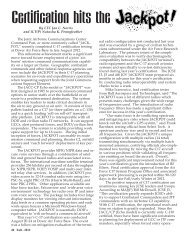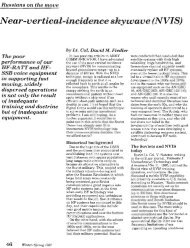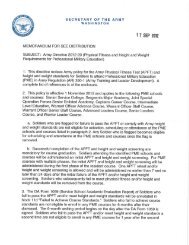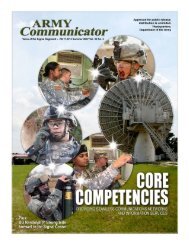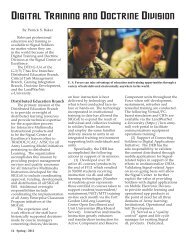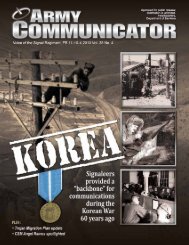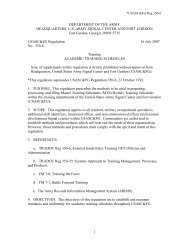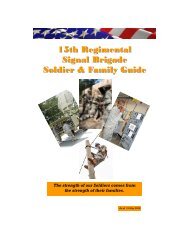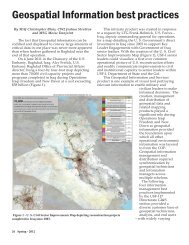AC Summer 08 WIN-T Online - United States Army Signal Center of ...
AC Summer 08 WIN-T Online - United States Army Signal Center of ...
AC Summer 08 WIN-T Online - United States Army Signal Center of ...
Create successful ePaper yourself
Turn your PDF publications into a flip-book with our unique Google optimized e-Paper software.
Wideband Networking Waveform (WNW)<br />
����� Available on JTRS GMR and AMF-SA radios<br />
mounted on vehicles and aircraft<br />
����� Supports brigade and below lower Tactical Internet<br />
backbone and local area networking, enables GIG<br />
interface for mounted/dismounted network and<br />
interconnects legacy and SRW subnets.<br />
����� Provides mobile ad-hoc dynamic IP routing:<br />
supports unicast, broadcast and multicast traffic.<br />
Optimized for network routing performance, network<br />
stability, and higher data throughput. Includes<br />
functionality sufficient to organize, manage, and<br />
dynamically control network connectivity structures,<br />
routing mechanisms, bandwidth allocations and<br />
spectrum restrictions. Supports concurrent<br />
applications <strong>of</strong> multi level priority traffic via advanced<br />
QoS implementation, including voice, data, and<br />
video applications.<br />
����� Network Throughput: 2 Mbps.<br />
����� Provides no native voice capability, but supports<br />
voice packet transport. Requires external voice<br />
application.<br />
����� Waveform operation between 225MHz and<br />
2000MHz but hardware constraints utilize frequency<br />
bands 225-400 MHz; 1350-1390 MHz; 1755-1850 MHz<br />
(banded PA 225-960 MHz, 1350-1850MHz).<br />
Soldier Radio Waveform (SRW)<br />
����� Available on JTRS HMS, GMR and AMF-SA.<br />
����� Supports local area networking for intra-unit<br />
communications in the air and ground domains.<br />
Optimized for CNR voice, dismounted/unmanned<br />
applications, and small form factors with severe<br />
SWaP constraints.<br />
� � � � � Provides IP based inter-networking and Mobile<br />
Ad-hoc Networking based Intra-networking<br />
capabilities. Supports unicast, broadcast and<br />
multicast traffic types. Network architecture assumes<br />
stub net configurations. Provides special power<br />
saving modes for IMS/UGS and Tele-ops mode for<br />
UAV/UGV.<br />
����� Network Throughput: 2 Mbps (with a single 1.2 MHz<br />
channel, INC 1)<br />
����� Provides native PTT based voice communications<br />
through SRW CNR voice application. Single SRW<br />
channel on a radio supports up to five logical voice<br />
nets simultaneously.<br />
����� Uses frequency bands 225-400 MHz; 1350-2500<br />
MHz<br />
����� Range: * 5 Km - SFF and Hand-Held form factors<br />
����� Range:<br />
* 10 Km: ground-to-ground<br />
* 28 Km: ship-to-ship, ship-to-shore<br />
* 370 Km: air-to-air, air-to-ground<br />
����� Embedded GIG compliant HAIPE (1.3.5) COMSEC<br />
suite. WNW network can be directly to the GIG.<br />
����� Supports robust dynamic IP routing protocols<br />
(OSPF, BGP) allowing the network to perform<br />
backbone routing and increases network scalability<br />
while interfacing with external networks (R-OSPF/ R-<br />
PIM [SM-DM] implementation within waveform).<br />
����� WNW Increment 1 modes <strong>of</strong> operation for the<br />
signal in space / physical layer:<br />
* OFDM – Bandwidth-efficient (2 bits/<br />
Hz target)<br />
* AJ – Anti-jam<br />
����� Employs selectable channel bandwidths (1.2 MHz,<br />
to 30 MHz) and variable data rates<br />
����� Frequency reuse implemented through automatic<br />
link adaptation (dynamic power and bandwidth<br />
allocation) using Link Adaptation Algorithm and<br />
Universal Slot Allocation Protocol.<br />
����� Scale to 250-node subnet size, without precluding<br />
scaling up to 1630 nodes.<br />
* 10 Km - Manpack and GMR<br />
����� AES based COMSEC/TRANSEC suite. Not fully<br />
HAIPE 3.x compliant. Requires Red Gateways in<br />
multi-channel JTRs to connect into the GIG.<br />
(Typically via WNW)<br />
����� Supports locally instantiated dynamic IP routing<br />
protocol (RIPv2) to perform IP network route<br />
discovery. Uses Link State based MANET routing<br />
protocol within SRW networks. Not designed to<br />
perform backbone routing.<br />
����� SRW Increment 1 modes <strong>of</strong> operation:<br />
*Combat Communications (CC) –<br />
Bandwidth-efficient (1 bit/Hz)<br />
*Electronic Warfare (EW) – Anti-jam (0.13<br />
bits/Hz) with DSSS spread<br />
� � � � � SRW supports selectable channel bandwidths<br />
(75 KHz to 32 MHz)<br />
����� Frequency re-use supported via spatial re-use<br />
and frequency agility. Supports dynamic link<br />
adaptation, contention based link access, as well as<br />
allocated link access.<br />
<strong>Army</strong> Communicator 73



